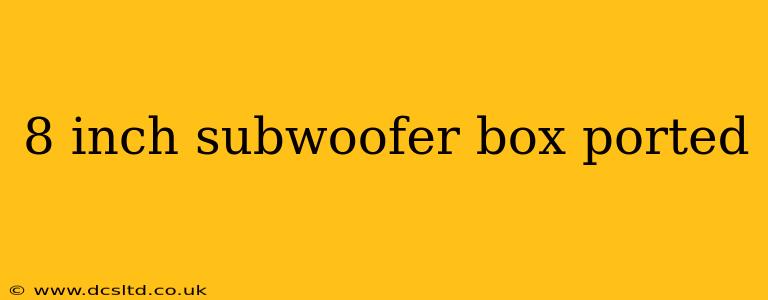Choosing the right enclosure for your 8-inch subwoofer is crucial for achieving optimal sound quality and performance. A ported (or bass-reflex) enclosure is a popular choice, known for its ability to extend low-frequency response and produce louder bass. However, designing a ported enclosure requires careful consideration of several factors. This guide will delve into the specifics of building a ported box for your 8-inch subwoofer, addressing common questions and concerns.
What are the benefits of a ported subwoofer box?
A ported enclosure uses a port (a tube or vent) to enhance the subwoofer's output, particularly in the lower bass frequencies. The port works in conjunction with the subwoofer to create a resonant system. Air moving in and out of the port supplements the subwoofer's cone movement, resulting in increased output and lower distortion in the subwoofer's tuning frequency. This translates to a louder and potentially deeper bass response than a sealed enclosure.
How do I calculate the port size and box volume for my 8-inch subwoofer?
This is where things get technical. Accurate calculations are essential for optimal performance. You'll need several pieces of information:
- Subwoofer's specifications: Consult your subwoofer's manual for its recommended enclosure volume (often expressed in cubic feet or liters) and its resonant frequency (Fs). These are crucial parameters for your calculations.
- Desired tuning frequency (Fb): This is the frequency at which the ported enclosure will resonate. Choosing the right Fb is vital. Too low, and you'll get a boomy, muddy sound. Too high, and you'll lose low-end extension. A common starting point is to aim for a tuning frequency slightly below the subwoofer's Fs. Many online calculators allow you to experiment with different Fb values.
- Port length and diameter: These are calculated based on the enclosure volume, tuning frequency, and port diameter. Several online subwoofer box calculators are available that will help you determine these values. Accurate measurements are critical here to achieve the desired results.
Important Note: While online calculators are helpful, it's strongly recommended to double-check your calculations and consider seeking advice from experienced audio enthusiasts or professionals before cutting and assembling the box.
What materials are best for building an 8-inch ported subwoofer box?
The choice of material depends on your budget and desired level of rigidity. Common options include:
- Medium-density fiberboard (MDF): This is a popular choice because it's relatively inexpensive, readily available, and provides good damping properties, reducing unwanted resonances.
- Particle board: Less expensive than MDF, but generally less rigid and prone to vibration.
- Plywood: Strong and durable, but can be more expensive and requires more careful cutting and assembly.
Regardless of the material chosen, ensure the chosen material is appropriately thick to prevent vibrations and maintain the integrity of the enclosure.
How important is bracing inside the ported subwoofer box?
Bracing is crucial for minimizing unwanted resonances and vibrations within the enclosure. Internal bracing adds rigidity, preventing the box from flexing, which can negatively impact sound quality. Strategic placement of bracing inside the box can significantly improve the sound.
Can I use a pre-made 8-inch ported subwoofer box?
Yes, pre-made enclosures are available from various audio retailers. This is a convenient option if you lack woodworking skills or the time to build one yourself. However, carefully verify the specifications of the pre-made box to ensure it's compatible with your subwoofer's requirements. Consider the internal volume, tuning frequency, and port dimensions.
What are some common mistakes to avoid when building a ported subwoofer box?
- Inaccurate measurements: Precise measurements are essential. Even small errors can significantly affect the final result.
- Poor sealing: Ensure all joints are tightly sealed to prevent air leaks, which can dramatically reduce performance. Use appropriate sealant or wood glue.
- Neglecting bracing: Inadequate bracing will lead to unwanted resonances and a less-than-optimal sound.
- Ignoring port design: The port's dimensions are crucial for achieving the desired tuning frequency. Improper port design can significantly impact performance.
By carefully following these guidelines and using available resources, you can build a high-performing ported enclosure for your 8-inch subwoofer, enhancing your listening experience with powerful and controlled bass. Remember that precision and attention to detail are key throughout the entire process.
